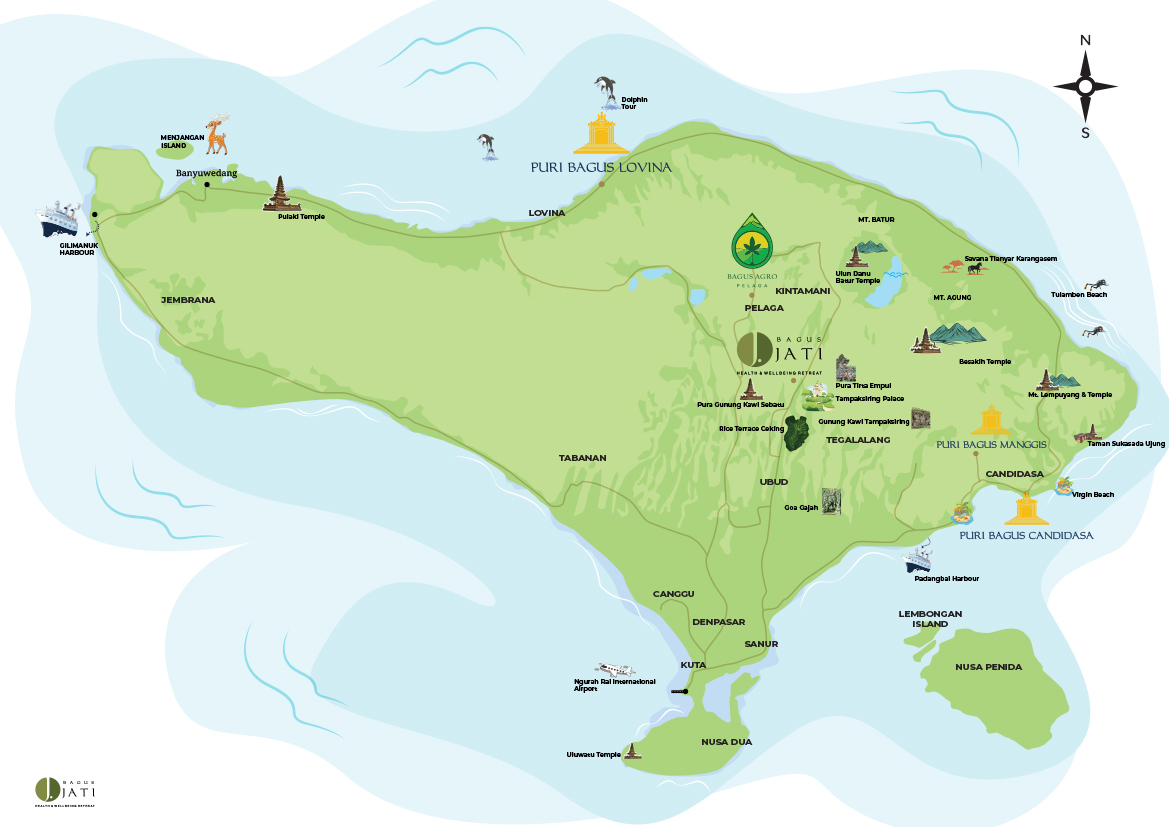BEST RATE GUARANTEE
Best Rate Guarantee

| Gunung Kawi Sebatu Temple | ± 3 Km | (10 minutes by car) |
| Gunung Kawi Temple | ± 6,5 Km | (20 minutes by car) |
| Rice Terrace Ceking Tegalallang | ± 7 Km | (15 minutes by car) |
| Tirta Empul Temple | ± 10 Km | (20 minutes by car) |
| Tampak Siring Palace | ± 11 Km | (20 minutes by car) |
| Tegalallang Handicarft Center | ± 12 Km | (25 minutes by car) |
| Royal Ubud Palace | ± 20 Km | (40 minutes by car) |
| Ulun Danu Batur Temple | ± 36 Km | (40 minutes by car) |
| Lake Kintamani | ± 37 Km | (45 minutes by car) |
| Denpasar | ± 51 Km | (1.5 hours by car) |
| Kuta | ± 60 Km | (2 hours by car) |
| Airport | ± 61 Km | (2 hours by car) |
Gunung Kawi Sebatu Temple, locally referred to as Pura Tirta Dawa Gunung Kawi Sebatu, is a special find for visitors to Central Bali. It is one of the least visited temple complexes on the island Bali, yet is one of the most beautiful and tranquil. It features verdant gardens around ponds filled with carp and blooming lotuses, and ancient shrines surrounded by crystal clear pools fed by natural springs.
Gunung Kawi Temple complex, locally referred to as Pura Gunung Kawi, is one of Bali’s most unique archaeological sites, comprising a collection of ancient shrine reliefs carved into the face of a rock cliff.
Across the river from the ancient reliefs is a temple courtyard featuring old Hindu shrines in a more contemporary architectural style.
CEKING Tegallalang Rice Terraces in Ubud is alone offers a scenic outlook that spreads down before you and away to the rice paddies on the slopes across the valley.
The famous for its beautiful scenes of rice paddies involving the subak (traditional Balinese cooperative irrigation system), which according to history, was passed down by a revered holy man named Rsi Markandeya in the eighth century.
Tirta Empul, meaning ‘holy water spring’ is actually the name of a water source located within the temple. The spring feeds various purification baths, pools and fish ponds surrounding the outer perimeter, which all flow to the Tukad Pakerisan River.
Various sites throughout the region and many other archaeological relics relate to local myths and legends.
The architect was R.M. Soedarsono and this palace was built in stages. Tampaksiring Palace consists of four main buildings namely Wisma Merdeka area of 1200 square meters and House Yudhistira 2000 square meters area and common room. Wisma Merdeka and Wisma Yudhistira is the first building that was built in 1957. At all the construction finished 1963 with the establishment of the Wisma Negara and Wisma Bima. This palace stood on the initiative of President Sukarno, who wants a resting place away from the cool weather of the city, suitable for the President of the Republic of Indonesia and their families as well as for state guests.
Tegallalang handicraft centre is famous for arts and crafts, located in the district of the same name just several kilometres north of the main Ubud hub. Although agriculture still remains the primary source of living among locals, the area and surrounding villages also produce a large variety of curios. Tegallalang handicraft centre owes to the various cottage industries found here, which deal with the manufacture and worldwide exports of an assortment of handicrafts and furniture items.
The Ubud Royal Palace is one of the most prominent places in Ubud, as it is smack-dab on the main Jalan Raya Ubud road and intersection. The palace can also be regarded as the focal landmark of Ubud. The Ubud palace was built during the lordship of the late Ida Tjokorda Putu Kandel (1800-1823), and is well-kept by his successive heirs. A visit to the Puri Saren is on many of the itineraries to the Ubud area. It has well-preserved Balinese architecture and charming garden settings, and is best known among lovers of Balinese arts as one of the main sites to view dramatic evening dance performances.
Ulun Danu Batur Temple is an important Balinese Hindu temple in Kintamani, central Bali. It’s also called ‘Pura Batur’ or ‘Batur Temple’ for short. The temple is the second most significant mountain temple after the Besakih Temple complex. Ulun Danu Batur sits at the southwestern rim of the vast caldera of Mount Batur. It features around nine majestic temples within its complex. There’s also over 200 different shrines and pavilions inside. The temple complex’s final site was established in 1926. This was after relocating from its original site at the foot of the volcano. Batur’s eruptions in 1917 and 1921 saw lava flows damaging the former site. Ulun Danu Batur is not to be confused with the similarly named Ulun Danu Beratan (the famous lake temple in Bedugul).
The Kintamani volcano or Mount Batur, in particular, is a very popular trek. The captivating Mount Batur surrounds the 13-square kilometre Batur caldera lake. Those with a penchant for adventure can take a winding road down to the lake shore.
This leads you to Toya Bungkah, Ulun Danu Batur temple, and a collection of hot springs. The Kintamani area consists of three main villages, namely Penelokan, Batur, and Kintamani.